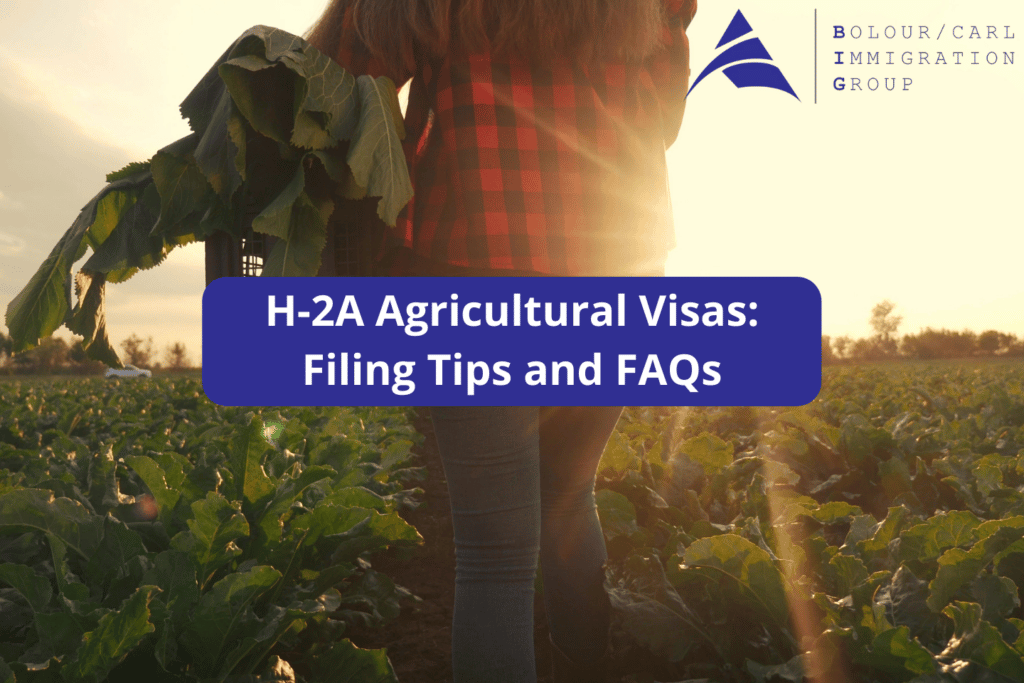
The H-2A agricultural visa program allows U.S. employers to bring foreign nationals to the United States to work in temporary agricultural jobs that they can’t fill domestically. Applying for an H-2A visa is a multi-step process, which begins with the employer. Below is what is involved, along with frequently asked questions.
How and When To Apply for an H-2A Visa
The U.S. employer must first complete the four-step H-2A Temporary Labor Certification process with the Department of Labor (DOL) through the FLAG online filing system:
- File and submit an agricultural job order, using Form ETA-790/790A, with the State Workforce Agency (SWA) that serves the state where the work will be performed. This should be done 60 to 75 days before the start of work.
- File an H-2A Application, using Form ETA-9142A, with the Chicago National Processing Center (NPC). This should be done at least 45 calendar days before the start of work.
- Once Chicago NPC accepts the application, immediately begin recruiting U.S. workers, following agency guidelines for where, when and how to advertise and how to complete a recruitment report.
- Once all required recruitment tasks have been fulfilled, complete the Temporary Labor Certification Process by submitting additional required documents to the Chicago NPC. This should be done at least 30 days before the start of work.
Upon receipt of an approved Temporary Labor Certificate, employers can file Form I-129, Petition for Nonimmigrant Worker with U.S. Citizenship and Immigration Services (USCIS).
Upon approval by USCIS of the employer’s petition, the foreign national worker will be notified to submit a H-2A visa application with the U.S. Department of State (DOS) and attend an interview at a U.S. Embassy or Consulate in their country.
H-2A Agricultural Visa Filing Tips
It’s important to file a thorough, accurate application since errors and omissions will cause unnecessary delays. Working with an agricultural visa lawyer will go a long way in assuring your application’s success. Below are some filing tips, to avoid common filing errors.
- To qualify for the program, the work must be seasonal, such as the production or harvesting of crops, or otherwise temporary in nature. Be specific when describing the type of agricultural work to be done, including the crops or commodities that will be produced. For temporary work other than seasonal work, such as an intermittent, peak load or one-time need, include a statement describing the nature of your operations and why the need is temporary.
- When you submit your agricultural job order to the SWA, remember to request an inspection of the housing you intend to provide for workers. If you plan to use rental or other public accommodations to house the workers, plan to provide documentation that such housing complies with the applicable housing standards, such as a certificate from the local or state Department of Health or building department.
- If you are offering an hourly wage rate, make sure to use either the current Adverse Effect Wage Rate (AEWR) established by the DOL or the prevailing hourly wage rate, which is set by the SWA, for your state.
- You will need to enclose a copy of your workers’ compensation policy, which must show the coverage will be valid through the requested period of employment. If your coverage will expire before the end date of need, you must provide proof of renewal or a signed assurance that it will be in place before the current policy expires.
- If you are unable to include all of the relevant information pertinent to an item on the Form ETA-790/790A, include a clearly labeled attachment.
- If you are a returning filer and your dates of need and/or number of workers are different from prior requests, include a statement explaining the reasons for the difference.
Frequently Asked Questions
Below are answers to common questions asked by H-2A visa candidates.
How long can I stay in the U.S. on an H-2A visa?
You will generally be granted H-2A status for as long as the time authorized on the temporary labor certification. Usually this will be one year or less. However, you can apply for an extension for qualifying employment in increments up to one year each. A new, valid temporary labor certification must accompany each extension request. After three years, you must leave the U.S. for at least three months before returning.
Can my family accompany me to the U.S.?
Your spouse and unmarried children under 21 years old may seek admission in the H-4 nonimmigrant classification for the same period as your authorized stay.
Can I travel on an H-2A visa?
Yes, you can travel in and out of the U.S. for as long as your visa is valid.
Can I apply for a change of status while on an H-2A visa?
Yes, you can apply to change your status. It is advisable that you consult an immigration attorney to weigh your options.
If you would like to speak to an H-2A agricultural visa immigration lawyer, contact Bolour/Carl Immigration Group at 323-857-0034 or [email protected].


